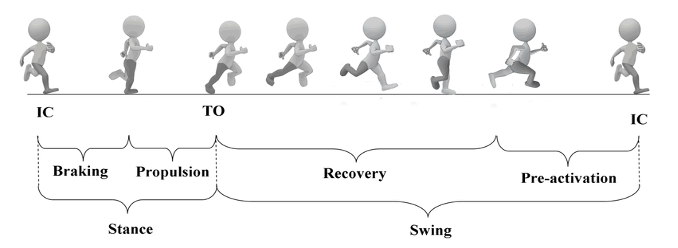With the year that was, training has needed to be more versatile than ever. With the infrequent access to group fitness classes and gyms, there has been a significant increase in the number of people commencing running or incorporating it into their training regime. There are many factors to consider when getting into this often-addictive sport; how far, how often, how quickly, where and with what shoes. This article aims to present the most important factors to consider on this journey to mitigate injury risk and provide some confidence to make running a lasting activity!
Let’s start by discussing running itself. Running differs from walking due to the flight (swing in image below) phase in which both feet are off the ground simultaneously. This flight phase requires more energy to get you off the ground and a large amount of control to absorb the landing. In fact, the ground reaction force is up to 250% of the body weight during running. The photo below demonstrates the varying stages of the running cycle.

If we start at the beginning of the cycle shown above, the braking phase engages the quadricep muscle group at the front of the thigh which controls the initial contact with the ground. After initial contact, the gluteal and adductor muscle groups came into play to stabilise before transitioning to propulsion. The toe off the ground is largely controlled by the calf muscles: gastrocnemius and soleus. If we look at the peak force during the running cycle the Lateral Quadricep, Gluteus Medius and Soleus which is one of the calf muscles have the largest role to play. Awareness of which muscle groups control each phase of movement aids the development of strengthening programs and conversely the design of rehabilitation programs following injury.

Strengthening programs
There is growing awareness and support for the application of strength and conditioning for all athletic endeavours, running inclusive. Strength training refers to working the target muscle (s) above normal demands via additional weight or training specificity. Strengthening in the running population directly impacts on running economy, which in conjunction with maximal oxygen uptake and the percentile of VO2 max are the primary influences on performance.
When we look at the frequency of strength training for mid-long-distance runners the current guideline is 2-3 sessions per week. The completion of strength training has been shown by Blagrove and colleagues (2017) to enhance running economy, time trial performance and maximal sprint. The type of strength training is varied across studies with the most positive impact emerging from heavy resistance training, explosive resistance training and plyometric training. From the perspective of injury prevention, inclusion of isometric resistance training throughout is adventitious.
Through running analysis, the degree of the degree of muscle load at various phases of the cycle has been determined. From this we can extrapolate specific strengthening exercises for running economy and performance. The Soleus (Calf) takes around 6 times bodyweight followed by Gluteus Medius at 4 times bodyweight and finally Vastus Lateralis (Quadricep) at 2.7 times bodyweight. An example of practical application, a Soleus heel raise at body weight which can then be progressed to 1-, 1.5- and 2-times body weight. The video attached below, demonstrates some foundational exercises that target these three muscle groups.
Running injuries
From a Physiotherapy perspective the context of the injury is always a priority. The way in which an exercise or strengthening program is prescribed will depend on the area of weakness or injury and training goals. During lockdowns, we had a population that was bound by their homes and lack of equipment which meant a drastic increase in running volume. The literature demonstrates lower limb injuries being the most common within the running population. See list below.
In order of prevalence:
- Patella tendinopathy
- Iliotibial band syndrome
- Patellofemoral pain syndrome
- Ankle sprain
- Achilles tendinopathy
- Plantar Fasciitis
- Hamstring strain or tendinopathy
- Medial tibial stress syndrome or ‘Shin Splints’
About 80% of running related injuries are due to overuse and this is where your Physiotherapist will tailor running volume, intensity, and duration pending presentation. In addition to strengthening there are other running parameters like cadence, foot strike and posture which may be altered to aid recovery. Conservative management is recommended as the first line of treatment so please liaise with your Physiotherapist to determine the best management plan for you.
Injury prevention
The current recovery timeframe from running related injuries is 72 days. This lengthy recovery time impacts on the capacity for performance, motivation to continue within the sport and monetary commitment to engage Physiotherapists or other health professionals to aid recovery. It is for this reason that there have been numerous studies evaluating the impact of varied running parameters on injury prevention.
For today’s consideration we will analyse stretching, intensity versus volume training, stretching, running parameters and shoe type.
Stretching and Warm Up
The use of a sport specific warm up or stretching is one that I have personally avoided from sheer laziness! A systematic review was conducted in 2012 to review the use of warm up on injury prevention across a range of sports. Results yielded a reduction in lower limb injuries with the use of a consistent (3 month, across all sessions) program of stretching, strengthening, balance, sports specific agility drills and landing techniques. Extrapolation of these results however is not direct as the benefit of warm up in the running population has not yet been evaluated. As the biggest causative factor in running injuries is an inappropriate increase in training load, it is difficult to evaluate the impact of stretching/warm up on injury prevention.
What we do know is that static stretching or the maintenance of an end-range position where the muscle is at maximal length should not be part of the warmup. Interestingly the effects of static stretching regarding the muscle length return to normal after 5-10 minutes so for us to conclude that they must exclusively be removed is important to consider in varied sporting populations. If we have a discrepancy between sides in terms of the sensation of tightness, pain, or a restriction in range, it is my opinion that would suggest intervention to address the issue. A muscle that is tight/painful would alter the range at which the joint can work within and alter the degree of muscle activation at that site and surrounding structures.
Training: volume versus intensity
Running volume and intensity are vital parameters for consideration due to their role in running related injuries. The Run Clever trial conducted in 2018 compared the prevalence of running related injuries in recreational runners when completing either a volume or intensity-based program over 16 weeks. Interestingly there was only a 3% difference in the prevalence of injuries between groups. Whilst this fails to guide us towards one training style, it does support the application of a graded structure. This was evident in this study during the transition period from pre-conditioning to specific intensity training, there was a greater number of injuries. This would likely be attributed to the greater change in exertion and training style.
From this we would assume that a graded training regime would subsequently reduce injury risk. However, prior studies have refuted the typical 10% increase in load over the course of a training program has no effect on running injury risk. This amplifies the need for further investigation in this multi-parameter sport.
Running parameters
Foot strike is again another contentious discussion point in the running community relative to energy expenditure aspect and injury management. Alterations in strike position may be implemented by your Physiotherapist to aid recovery and minimise irritation to the structure under assessment. For example, the use of a forefoot strike has been shown to reduce the patellofemoral load, which in individuals suffering with anterior knee pain may enhance recovery. This decision however demands clinical discretion. Your therapist will assess the sequelae of altering your strike pattern as a change to a forefoot strike does increase the load at the foot and ankle which is not going to assist someone presenting with heel pain.
Cadence is the number of steps taken per minute. Changes to running cadence may form part of your running rehabilitation due to the substantiated reduction in peak impact force. Increases in running cadence 5-10% above usual running rate reduces the demand of the joints within the lower limb which can aid injury recovery during rehabilitation. As we can imagine, the introduction of a quicker step rate subsequently reduces stride length which has another benefit to biomechanics at the knee and reduces forces here also.
Shoe type
When it comes to running shoe selection there are a few options available to us. Previously, shoe selection has been guided by foot posture: neutral, pronated or supinated demanding a specific type of shoe. Recent studies have shown however that the pronation was not associated with running injury, debunking the notion of foot postures needing to be recorrected or supported by a specific shoe type. Additional studies conducted in 2019 refuted the notion that comfortable shoes reduce injury risk and improve oxygen consumption (running efficiency). So where does this leave us regarding shoe choice?
For running shoe selection, it is important to consider that large changes in footwear regarding degree of support may alter the loading pattern and in turn predispose the individual to injury. Within reason we also see improvement in running efficiency with lighter shoes. From the inception of carbon fibre plate shoes in 2016 there has been a 4% improvement in running economy and a 2% improvement in performance.
Summary:
Despite the myriad of resources available, this deep dive highlights the demand for further investigations across a range of skill levels, male and female athletes, and over varying distances/performance goals.
Running is an extremely fulfilling activity however that should continue to be encouraged and supported in its continuation. If you have any questions or wish to engage a Physiotherapist for a rehabilitation plan or injury management, please give us a call as we look forward to working with you! Run on!

